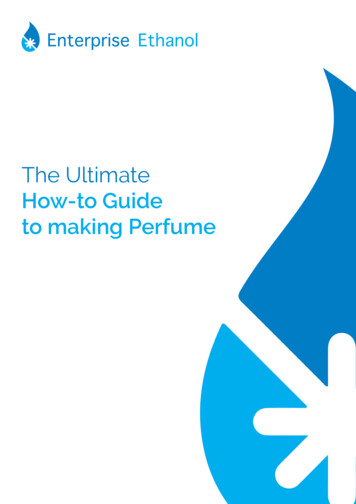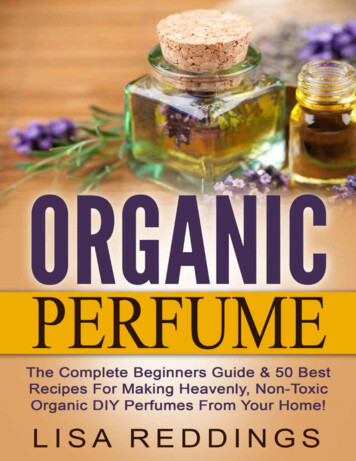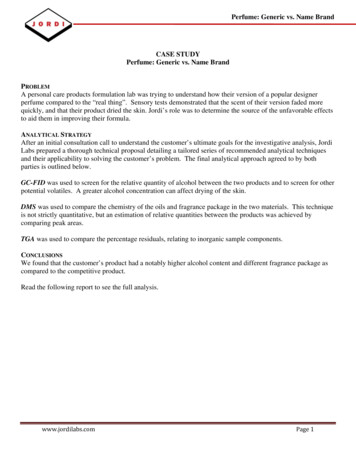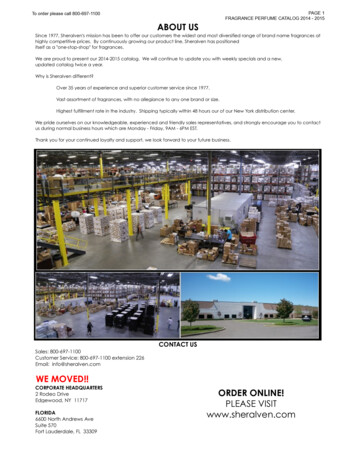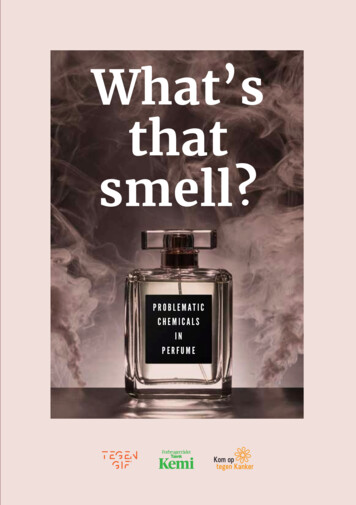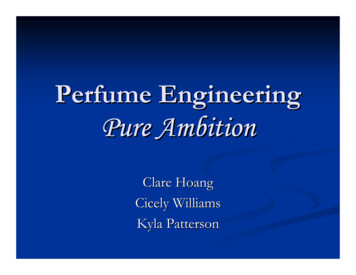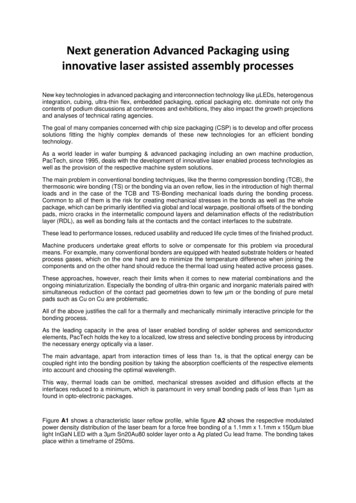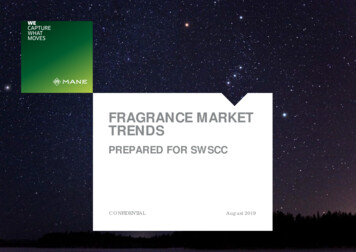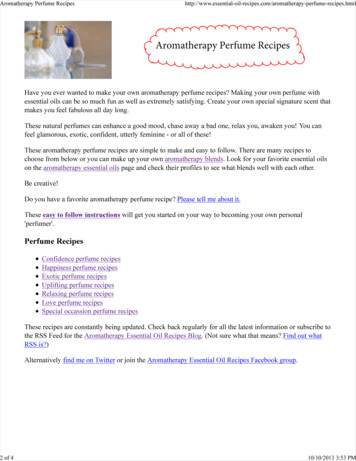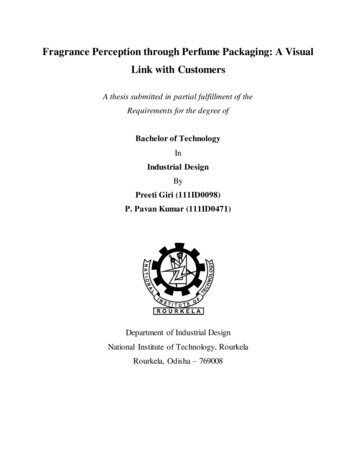
Transcription
Fragrance Perception through Perfume Packaging: A VisualLink with CustomersA thesis submitted in partial fulfillment of theRequirements for the degree ofBachelor of TechnologyInIndustrial DesignByPreeti Giri (111ID0098)P. Pavan Kumar (111ID0471)Department of Industrial DesignNational Institute of Technology, RourkelaRourkela, Odisha – 769008
DeclarationWe Hereby Declare That This Thesis Is Our Own Work And Effort. Throughout ThisDocumentation Wherever Contributions Of Others Are Involved, Every Endeavour Was Made ToAcknowledge This Clearly With Due Reference To Literature. This Work Is Being Submitted ForMeeting The Partial Fulfilment For The Degree Of Bachelor Of Technology In Industrial DesignAt National Institute Of Technology, Rourkela For The Academic Session 2011 – 2015.Preeti Giri (111ID0098)Palarapu Pavan Kumar (111ID0471)i
NATIONAL INSTITUTE OF TECHNOLOGYROURKELA 769008, INDIACertificate of ApprovalThis is to certify that the thesis entitled “FRAGRANCE PERCEPTION THROUGHPERFUME PACKAGING: A VISUAL LINK WITH CUSTOMERS” submitted to theNational Institute of Technology, Rourkela by PREETI GIRI, Roll No. 111ID0098 andPALARAPU PAVAN KUMAR, Roll No. 111ID0471 for the award of the Degree ofBachelor of Technology in Industrial Design Engineering is a record of bona fide researchwork carried out by then under my supervision and guidance. The results presented in thisthesis has not been, to the best of my knowledge, submitted to any other University orInstitute for the award of any degree or diploma. The thesis, in my opinion, has reached thestandards fulfilling the requirement for the award of the degree of Bachelor of technology inaccordance with regulations of the Institute.Dr. Mohammed Rajik KhanAssistant ProfessorDepartment of Industrial DesignNational Institute of Technology, RourkelaDate:ii
AcknowledgementWe have taken efforts in this project. However, it would not have been possible without thekind support and help of many individuals and the department. We would like to extend oursincere thanks to all of them.We would like to express our gratitude and special thanks to our project guide Dr.Mohammed Rajik Khan, Assistant Professor, Department of Industrial Design, NIT Rourkela,for all the cooperation and time. We would also like to thank our head of the department Prof.Bibhuti Bhusan Biswal for giving us such attention and time.Our especial thanks to all the students as well as Professors for giving their whole heartedcooperation in participating in the survey conducted by us.Preeti Giri (111ID0098)Palarapu Pavan Kumar (111ID0471)iii
AbstractVisual interaction remains the central ideology of perfume packaging industry. To achievethis ideology, packaging must clearly establish a complete sensory relationship between thecustomer and the product which includes visual, aroma and tactile elements. The aim of thisresearch work is to identify the key factors that affect customers’ buying preferences and thuspropose a methodology that will represent the fragrance in form of visual cues. To understandthe customer’s buying pattern of perfumes, an online survey was conducted in which 78candidates participated (20 female, 58 male). ANOVA analysis was conducted using SPSSsoftware to analyse the results procured from the online survey. Results clearly indicate thatvisual cues affects the decision making process during purchase of perfumes. The proposedmethodology may provide a useful guideline to the perfume packaging industry inestablishing harmony between customer’s perception of the perfume and the fragrance ofperfume in reality.Keywords: Human-product interaction, customers’ preferences, SPSS, ANOVAiv
C o nt e nt ctivContentsvList of FiguresviiList of Tablesix1. Introduction11.1 Background21.2 Motivation21.3 Problem Definition21.4 Fragrance classification based on gender requirements3v
1.5 Colour principles in packaging51.6 Review of Literature81.7 Objectives of the work91.8 Advantages of Proposed Methodology101.9 The Layout of the Thesis102. Methodology112.1 Proposing Faces of perfume selection pattern122.2 Identifying consumers’ psychology towards existing perfume packaging142.2.1 Consumers fragrance perception in existing packaging172.2.2 Consumers emotions towards packaging193. Results and Discussion213.1Design Framework223.2Implementation of Design Framework244. Conclusion285. Scope of future work29References30Appendix A33Appendix B38vi
List of Figures1. Classification of fragrances32. Framework of purchase pattern of customers falling in Class A123. Framework of purchase pattern of customers falling in Class B134. Consumer’s perception towards fragrance on visualizing forms175. Consumer’s perception towards fragrance on visualizing colours186. Candidates’ responses towards shape related emotions207. Candidates’ responses towards colour related emotions208. Basic attributes for design framework239. Design framework for the package designers2410. Concept ideation of Floral category perfume2511. Modification to the (a) bottle no.12 floral perfumethrough concept sketches for (b) 18-25 years (c) 25-35 years12. Concept ideation of Fresh category perfume252613. Modification to the (a) bottle no.41fresh perfumethrough concept sketches for (b) 18-25 years (c) 25-35 years14. Concept ideation of Fruity category perfume262715. Modification to the (a) bottle no.39 fruity perfumethrough concept sketches for (b) 18-25 years (c) 25-35 years27vii
16. Pie diagram representation of responses obtained based on genderCategorization4117. Bar diagram representation of responses obtained for types of perfumepreferred by consumers4218. Bar diagram representation of responses obtained for the time ofapplying perfume4219. Pie diagram representation of responses obtained for graphics orstyling of perfume bottle affecting the choice of perfume4220. Pie diagram representation of responses obtained for seasonalchanges affecting the choice of perfume4321. Bar diagram representation of responses obtained forCylindrical shape4322. Bar diagram representation of responses obtained forSpherical shape4323. Bar diagram representation of responses obtained forCuboidal shape4424. Bar diagram representation of responses obtained forConical shape4425. Bar diagram representation of responses obtained forPrismatic shape4426. Bar diagram representation of responses obtained forAbstract shape44viii
List of Tables1. Fragrance Classification on the Basis of Gender Requirements42. Colour Principles63. Data for performing ANOVA analysis154. Analysis of variance (ANOVA) for Consumer’s selection value.165. Categorization of perfume bottles as per the fragrance familyand the candidates’ perception18ix
1. I nt r o duc t io nCustomer’s purchasing decision process is a complicated one which is mostly affected byadvertisement, information exchange through social media and online customer reviews,social and psychological factors. Visual attributes of products like perfumes is the mostvital factor that influences a consumer’s buying process when a selection has to be madebetween products of same range and quality. With the rapid growth of online shopping andself-service retail shopping, targeted package design plays a great role in assisting theselection process of a consumer. Intelligent and creative package design can stronglyattract a consumer when products have the same utilitarian qualities but with differentaesthetic features or what are specifically termed as the hedonic qualities.
1. IntroductionThis chapter develops the background for the present work and discusses the need to takeup this work. It presents a review of available relevant literature. Objectives of the presentwork along with methodology adopted to accomplish them are also discussed here.1.1 BackgroundAttracting customers through visual attributes remains the central ideology of kagedesignersusedifferentmethodologies to communicate their concept behind the theme of packaging. Eachpackaging industries use the art of story-telling to pass along their concept ideations to theconsumers. But with the growth of self-service retail shopping and online shopping,customers find difficult to connect to their choices. This in turn induces disharmony amongthe consumers if their choices during purchase don’t reflect the aroma in the usage period.This induced disharmony may lead to the reduction in sales of that particular perfume.Rather focussing on only beautifying the product, package designers should orient thepackaging in order to communicate the nature of aroma along with the gender basedpreferences through aesthetically pleasing visual attributes1.2 MotivationWith the growth in online shopping and self-service retail shopping, it becomes mandatoryto communicate the olfactory nature of perfume. In self-service retail shopping, consumersgo for testing the fragrance of each and every selected perfume one by one. This creates lotof confusion and takes lot of time to find out their desired choice. In online shopping,customers have to make their selection only by seeing the visual attributes and reading outthe product specifications provided in the site. In these cases, representing fragrancethrough visual attributes becomes most essential element of perfume branding andmarketing.1.3 Problem DefinitionThis works makes an attempt to develop a novel unified representation scheme that canprovide guidelines to packaging industries in terms of representing the fragrance ofperfume through aesthetic features. In view of the importance of developing design2
1. Introductionframework for the packaging and branding industries, we formally state the problemsundertaken in this work as follows:(i)The packaging style adopted in present scenario is mostly gender oriented.Beautifying the packaging becomes the sole motive of packaging industries. Thiscreates a lot of confusion in customer’s frame of mind as they get completelydistracted as to what they should choose.(ii)The existing packaging style doesn’t convey any information about the type ofperfume present in the perfume bottle. This makes ignorant customers to go fortesting one by one perfume. This leads to wastage of time and places consumers ina perplexed situation when it comes to settling on their choices firmly.(iii)There is significant disharmony generated between customer’s perception andfragrance in reality. This reduces consumer’s loyalty towards a particular brand.1.4 Fragrance Classification based on Gender RequirementsThe Fragrance wheel as proposed by Michael Edward [1] is a new classification methodwhich is widely used in the fragrance industry. This new method was developed tosimplify classification of fragrances and also to show the relationships between eachindividual classes. The fragrance wheel is represented in figure1. These are some basic andstandard notes used in olfactory industry all over the world. Some variations are present inthese notes according to their callout ingredients to suit gender choices and personalrequirements.Figure.1 Classification of fragrances3
1. IntroductionThe table1 demarcates the olfactory families and their sub families according to genderpreferences.Table1: Fragrance Classification on the Basis of Gender RequirementsGenderOlfactory FamilySub FamilyChyprusIt is based on a woody, mossy, floral accord and can Floralinclude leathery or fruity notes as well. These have a rich Fruityand lingering scent.CitrusPerfumes of this category mainly consist of citrus scents Aromaticsuch as bergamot, lemon, orange, tangerine andgrapefruit. These perfumes are fresh and light.FloralFemaleAldehydeFloral is most widely used note in women’s perfumes. AquaticThese can be enriched with green, aldehyde, fruity orCarnationspicy notes.GreenOrientalThese are also known as “amber” fragrances. Famous fortheir unique blend of warmth and sensuality. TheyFloralSpicycontain substances like musk, vanilla and precious Woody muskwoods and often associated with exotic floral and spicyscents.Vanilla4
1. IntroductionAromaticThese notes primarily consist of sage, rosemary, thymeAquaticFougereand lavender generally complemented with spicy and Freshcitrus notes. These are majorly used in men’s perfumes.RusticCitrusThis family includes all perfumes mainly composed of Aromaticcitrus notes such as bergamot, lemon, orange, tangerineMaleand grapefruit. These fragrances are fresh and light.OrientalThese perfumes draw their richness and sophisticationFougereSpicyfrom substances such as amber, resin, tobacco, spices Woodyand exotic woods.AquaticWoodyAromaticThese warn, dry and elegant masculine accords oftencontain a small amount of citrus or aromatic notes. ChypreThese perfumes are warm and opulent when based on Floral Musksandalwood.Spicy1.5 Colour Principles in PackagingColour assumes an imperative part in designing any product. It excites viewers' feelingsand a bearer that originators use to convey data. Colours that are seen together producesatisfying emotional reactions are thought to be in harmony. In design, it has beenrecommended that positive feeling would increase the value of an item as well as can5
1. Introductionfurther expand the likelihood of an item being repurchased. Accordingly, when planningitems, designers attempt to build passionate associations among thoughts, items, customersand brands. Utilizing harmonious colours is one approach to make positive passionateassociations. This colour harmony can be created by using some principles of colourcombinations which has been recommended by many previous studies. Moon and Spencer[2] suggested that effect of hue difference plays an important role in creating colorharmony. Various theories and studies proposed both equal-hue and complementary-hueprinciple. Various numbers of studies proposed an equal-chroma principle which suggestedthat when two colours are equal or similar in chroma, their colour combination would lookharmonious. Further, Ou and Luo [3] suggested a similar principle of colour harmony, i.e.,equal-hue and equal-chroma principle which states that resemblance in hue and chromabetween individual colours in a colour pair results in colour harmony. In addition to these,a number of previous studies also suggested some lightness-related principles. They areequal-lightness principle proposed by Szabo et al. [4], complementary-lightness principleproposed by Munsell[5] and Szabó et al. [4] and high-lightness principle proposed by Ou& Luo[3] and Szabó et al. [4].Table2: Colour Principles [6]ColourHarmonyDescriptionsStudiesEqual-hue principleColours harmonise if they are ofPrinciplesthe same sColours harmonise if they arecomplementary in hue.Blues tend to create colourBlue principleharmony; red tend to createcolour disharmony.Yellow principleBright yellows tend toharmonise with6
1. Introductionother colours in a colour pair;dark yellow (brown) tend todisharmoniseChroma-relatedEqual-chroma principleprinciplethe same ChromaEqual-lightness principleLightness-Colours harmonise if they are ofComplementary- lightnessPrinciplerelatedprinciplesColours disharmonise if they areof the same lightnessColours harmonise if lightnessof the two colours crosses thelightness of 50.The higher the lightness ofHigh-lightness principleindividual colours, the moreharmonious the colour pairgenerated by them.Colours harmonise if they are ofEqual-tone principlesame chromaConjointprinciplesthe same lightness and of theResemblance in hue and chromaEqual-hue & equal-chromaPrinciplebetween individual colours in acolour pair results in colourharmonyThe colour principles discussed in table 2 are general colour rules and in packaging. Onlyequal hue and equal hue and equal chroma tend to agree with customers’ response onseeing a packaged product.The colour psychology accounts for 85% of reason why someone decides to purchase aproduct. Some of the colours used in olfactory industry and the emotions related to it arelisted below.Pink and Violet: Associates with feminity, evokes eleganceGreen: Associates with nature and evokes feelings of relaxation and calmness.Blue: Relates to aquatic and elicits responses of comfort and moisture.7
1. IntroductionRed: Symbolizes sensuality in package designs. It is used to represent characteristics likedominance, strong, spicy and sensualityBlack: Symbolizes power and masculinity.Yellow and Orange: Relates with happiness, freshness.Women generally tend to prefer blue, yellow, orange , pink , purple and red colourswhereas man are generally attracted to blue, black, brown, green and red.1.6 Review of LiteratureBeauty and fragrance industry insiders weigh in on the importance of fragrance in beautyproduct branding, as well as the best ways to carry it out. Complete sensory connectionsare central in the success of a product. These cues include visual, aroma and tactileelements. Many researchers are working in this area so as to enhance the link and set astrong relationship between the fragrance, perfume branding and customers’ psychology.Allyn et al. [7] have discussed the sensory connections of fragrance branding. Mcewen [8]has discussed about the presence of strong emotional features in branding or any beautyindustry. Further Anna Lindquist [9] discussed on the commercial gender categorization ofperfumes related to consumer preference of fragrance. Packaging, colour tones, calloutingredients and storytelling are all important elements to consider in creating a product.Brian morean [10] discussed the colours of smell and the effects of colours in perfumeadvertising and senses. Tornetta et al. [11] reviewed the influence of colours onconsumers’ psychology and further discussed the use of colours in packaging industries.Bacci et al. [12] discussed the uses of different colours to define different brands. Further,the impact of colour traits on corporate branding has been discussed by Chang et al. [13].Hemphill et al. [14] further worked on the adults’ colour-emotion associations. Stanger etal. [15] reviewed about how the brands use the psychology of colour to manipulatecustomers. Further, work is being done to identify the possible design features thatassociate directly or indirectly with the fragrance. Ravindra Chitturi [16] has proposed acomprehensive model showing the relationshipbetween trade-off decisions duringpurchasing and post consumption experience. The work showed how discrepanciesbetween these attributes can lead to negative emotions and thus impact consumer loyalty.Demir et al. [17] have suggested an approach to design products with an intention togenerate or prevent certain types of emotions. The work elicited upon the appraisal patterns8
1. Introductionof the emotions in human-product interaction. On the other hand, Bloch [18] has provideda deeper insight into buying behaviour by establishing a model on customer responses toproduct aesthetics. Lesot et al. [19] have presented a work related to impact of emotionaldesign on products’ shape and discussed its implementation in perfume packaging. AliRaza et al. [20] have conducted a case study to identify the most influential factors that areintegral to perfume buying process. Sarah Wills [21] did a comparative study betweenpackaging design and customer reviews and their influences on fragrance buying decisions.Wang Tien-You [22] has analyzed the importance of customers’ preferences in perfumebottle design and has provided designers a new way of product design so that they canimprove their market competitiveness. Presently, perfume branding industries rely ongender based representation of perfumes. This results into disharmony between theperception of fragrance and perfume in reality. Thus, representing the fragrance along withthe gender preferences through visual attributes remains a challenging issue in the perfumebranding and marketing industry. So, efforts must be put to design perfume bottle in a waythat it provides a harmony between colour tones used, shape of the perfume bottle and thefragrance and thus give consumer a hassle free experience while selecting perfumes.1.7 Objectives of the WorkThe work aims at(i)To conduct a subjective assessment to understand the consumer’s psychology andbehavioral manifestations when they are exposed to large variety of perfumes.(ii)To develop a design framework combining the key attributes that needs to beimplemented in the packaging style so as to eliminate the disharmony betweencustomer’s perception and fragrance in reality(iii)To develop concept sketches for the most disharmonious designs so that the modifieddesigns can better communicate the gender and age based preferences along with theolfactory nature of perfume.9
1. Introduction1.8Advantages of the Proposed Design FrameworkThe advantages of the proposed design framework may include:(i)Helps customers in settling on their choices in minimum possible time and providecustomers a hassle free experience while purchasing perfumes.(ii)Creates harmony between customer’s perception and the fragrance in reality and thusfrees customers from an ambiguous situation.(iii)Instills consumer’s loyalty towards a particular brand and promotes positiveadvertisement of the brand.1.9The Layout of the ThesisA brief overview of the work carried out in the thesis and organization of the same aresummarized below.Chapter 1 presents the background, motivation and problem definition of the thesis work.Here, brief information is given for the fragrance categorization according to genderpreferences and colour principles used in packaging industries. It is followed with a briefreview of the relevant literature. This chapter concludes with the objectives of the workalong with the advantages of the proposed design framework.Methodology adopted is presented in Chapter 2. The chapter proposes the faces of perfumeselection pattern and discusses the level of interaction of each factor with customer’spurchasing decision. It also identifies consumer’s psychology in existing packaging stylethrough the online survey conducted.Chapter 3 deals with the results and discussions. Proposed design frame work is presentedin this chapter. The concept sketches of the most disharmonious perfume bottles have alsobeen presented in order to validate the proposed design frameworkChapter 4 summarizes the significant findings of the work performed, outline the currentlimitations raised by the proposed methodology as well as provide some recommendationsfor future work that would further enhance the unified representation scheme along withdesign methodology for packaging of different items like fruit juices and food items.10
2 . M e t ho do lo g yThe chapter discusses the methodology adopted to identify the various factors important inpurchasing of perfumes. The chapter outlines the level of interaction of key attributesintegral to perfume selection. Understanding the level of interaction of each factor helps toidentify the higher priority factors. Consumer’s psychology towards the existing packagingstyle helps to know the specific positive emotions that are invoked on visualizing shapesand colours of perfume bottles. To understand consumer’s behavioral responses, an onlinesurvey is conducted where 78 candidates of 18-35 years participated. The responseselicited the consumer’s mentality towards the packaging style. After conducting thesurvey, the responses have been analyzed using statistical tool (ANOVA). The analysisreported significant weightage to form design and colours used in the context of packaging.
2. Methodology2.1 Proposing Faces of perfume selection patternThe selection pattern of a consumer is a very complex process. The preference pattern canbe more intriguing when exposed to a large variety of perfumes especially in the cases ofonline shopping or self-service retail shopping. The key attributes that drive a customer’sselection pattern are his/her own fragrance and brand preferences, advertisements, onlinereviews, earlier usage experience and the product’s physical appearance. Here, we havecategorized customer’s purchasing patterns of perfumes under two classes.a.) Class A: Purchase pattern unaffected by social factors and product aestheticsThese customers develop a liking towards a particular perfume and are not in a state to gofor change. The inclination is developed due to quality and usage experience. Packagingaesthetics may or may not affect their inclination towards a particular perfume. Thecustomers falling in this category don’t have any confusion regarding the selection criteria.For this category of customers, utilitarian benefits matter the most and hedonic or aestheticfeature don’t play any deciding role in their selection criteria. Selection time remains theleast as they are aware of what to purchase.Figure2. Framework of purchase pattern of customers falling in Class Ab.) Class B: Purchase pattern affected by personal choices, social factors and productaesthetics.These customers are in a state of complete confusion as to what they should purchase asthey have no clue about their own preferences. These customers set their choice ofparticular fragrance or brand through social factors like online reviews, informationexchange through social media, advertisement, past usage experience etc. and physicalappearances. The customers mind set changes according to seasonal changes, occasions,12
2. Methodologyplace of use, etc. Selection time increases to a large extent if customers find difficulty inassociating with the perfume through visual cues.Figures 1 and 2 clearly depict the framework for the interaction level of various factorswith the purchase pattern of a consumer.Figure3. Framework of purchase pattern of customers falling in Class BThe nomenclature of interaction levels is discussed: R: Represents positive emotion/relation towards purchasing choice among thecustomers who are inclined to a particular type of fragrance and brand. S1: Choice of fragrance/brand is strongly affected by social factors. The customerdevelops a preference by going through various forms of advertisements, socialmedia, and online reviews and past usage experience of his own or others. S2: Choice of fragrance/brand remains unaffected by social factors P1: Choice of fragrance/brand is strongly affected by physical appearance. Thecustomer develops a preference by visualizing the physical characteristics like form13
2. Methodologydesign, colours, size and graphics. Such aesthetics oriented choices are driven bygender and age preferences and the personality traits. P2: Choice of fragrance/brand remains unaffected by physical appearance E1: All the attributes (choice of fragrance and brand, social factors and physicalappearance) together generate a positive emotion towards purchasing of theparticular perfume. E2: All the attributes (choice of fragrance and brand, social factors and physicalappearance) together generate a negative emotion towards purchasing of theparticular perfume.2.2 Consumers’ psychology towards perfume packaging: A SubjectiveassessmentFrom the framework of purchase pattern, it is known that hedonic features play a majorrole when a consumer is exposed to a huge variety of perfumes. The hedonic benefitsassociated with any perfume contribute a lot to its marketing when choices have to bemade between perfumes of same fragrance category. Uncertainty and confusion inselection pattern rises if the physical features don’t clearly indicate the type of perfume.This directly results into disharmony between the consumer’s perception and the perfumein reality and thus leads to consumer’s dissatisfaction.To understand the consumer’s psychology, an online survey was conducted where 78candidates from different age group and background participated. The questionnairepattern (Appendix A) is prepared in a way to extract the important requisites of perfumepackaging. 54 pictures of perfume bottles of different fragrances, brands and aestheticswere placed in questionnaire and the candidates were asked to make judgements as per thequestions. The response pattern was studied and analyzed using statistical tool (ANOVA).ANOVA analysis was performed using SPSS software to know the effect of shape andcolour of perfume bottle in consumer’s selection of perfume bottles. Shape and colour ofperfume bottles are considered as inputs and consumer’s selection is considered as output(Table). Bottle shapes considered for the analysis are Cylindrical, Spherical, Cuboidal,Conical, Prismatic and Abstract. Colours considered for the analysis are White, Blue,Yellow, Pink, Black, Violet, Green and Red. 54 bottles given in the survey are categorizedunder these shapes and the bottles of complex shape were grouped under Abstract shape.14
2. MethodologyIn the same way, bottles are grouped under the given colours. Consumer’s selection scoreis obtained from the responses of question no.8 asked in the survey (Appendix A) which isrelated to overall colour and shape of the bottle. Bottles with Rank1 are assigned a scorevalue of 3, those with Rank2 are assigned a value of 2 and those with Rank3 are assigned avalue of 1.Bottles with combination of particular shape and particular colour are multipliedwith their respective scores and summed up to obtain overall score. The combinations withscore value of 0 are neglected for the analysis. The responses along with all the analysishave been presented in appendix BTable3: Data for performing ANOVA analysisShapesColoursConsumer’s selection n5ConicalBlue2115
2. MethodologyConicalYellow17ConicalPin
ii NATIONAL INSTITUTE OF TECHNOLOGY ROURKELA 769008, INDIA Certificate of Approval This is to certify that the thesis entitled “FRAGRANCE PERCEPTION THROUGH PERFUME PACKAGING: A VISUAL LINK WITH CUSTOMERS” submitted to the National Institute of Technology, Rourkela by PR
